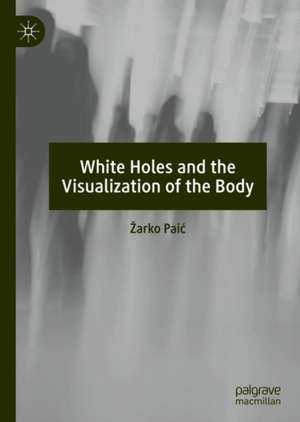White Holes and the Visualization of the Body
Autor Žarko Paićen Limba Engleză Hardback – 14 mai 2019
This book builds on the works of Artaud and Deleuze, setting forth a different way of thinking on the body through the use of a whole new set of conceptual tools. Paić argues that the human body has become obsolete in relation to the development of cybernetics and artificial intelligence, proposing that it can be understood neither as a bare thing nor a machine, but instead as an event.
The concept of White Holes serves both as a metaphor and as a guide for understanding constellations such as the visualization of the body, the corporeal turn, fascination with the digital image, and the technosphere. Through visualization of the body, we reach out to a space of singularity of thought that is not a description of reality, but rather its aesthetic construction. Leading a paradigm shift after the end of metaphysics in cybernetics, Paić argues that phenomenology and psychoanalysis can no longer be credible theoretical orientations for deep insight into what happens when artificial life takes over what remains of the body's immanence.
The concept of White Holes serves both as a metaphor and as a guide for understanding constellations such as the visualization of the body, the corporeal turn, fascination with the digital image, and the technosphere. Through visualization of the body, we reach out to a space of singularity of thought that is not a description of reality, but rather its aesthetic construction. Leading a paradigm shift after the end of metaphysics in cybernetics, Paić argues that phenomenology and psychoanalysis can no longer be credible theoretical orientations for deep insight into what happens when artificial life takes over what remains of the body's immanence.
Preț: 470.24 lei
Preț vechi: 553.22 lei
-15% Nou
Puncte Express: 705
Preț estimativ în valută:
89.98€ • 94.20$ • 74.45£
89.98€ • 94.20$ • 74.45£
Carte tipărită la comandă
Livrare economică 07-21 aprilie
Preluare comenzi: 021 569.72.76
Specificații
ISBN-13: 9783030144661
ISBN-10: 3030144666
Pagini: 197
Ilustrații: VIII, 194 p.
Dimensiuni: 148 x 210 mm
Greutate: 0.4 kg
Ediția:1st ed. 2019
Editura: Springer International Publishing
Colecția Palgrave Macmillan
Locul publicării:Cham, Switzerland
ISBN-10: 3030144666
Pagini: 197
Ilustrații: VIII, 194 p.
Dimensiuni: 148 x 210 mm
Greutate: 0.4 kg
Ediția:1st ed. 2019
Editura: Springer International Publishing
Colecția Palgrave Macmillan
Locul publicării:Cham, Switzerland
Cuprins
1. Introduction.- 2. The Return to the Body.- 3. The New Theory of Subject.- 4. Anti-philosophy of Immanence.- 5. Life as a Biopolitical Machine.- 6. Event and Difference: Performative-Conceptual Turn of Contemporary Art.- 7. Conclusion.
Notă biografică
Žarko Paić is a Professor at the University of Zagreb, where he teaches courses in Aesthetics and Media Theory. He publishes frequently in philosophy, social sciences and art theory. His publications include Theorizing Images, eds. with Krešimir Purgar (2016), and Technosphere Vol. 1-5 (2018-2019).
Textul de pe ultima copertă
This book builds on the works of Artaud and Deleuze, setting forth a different way of thinking on the body through the use of a whole new set of conceptual tools. Paić argues that the human body has become obsolete in relation to the development of cybernetics and artificial intelligence, proposing that it can be understood neither as a bare thing nor a machine, but instead as an event.
The concept of White Holes serves both as a metaphor and as a guide for understanding constellations such as the visualization of the body, the corporeal turn, fascination with the digital image, and the technosphere. Through visualization of the body, we reach out to a space of singularity of thought that is not a description of reality, but rather its aesthetic construction. Leading a paradigm shift after the end of metaphysics in cybernetics, Paić argues that phenomenology and psychoanalysis can nolonger be credible theoretical orientations for deep insight into what happens when artificial life takes over what remains of the body's immanence.
The concept of White Holes serves both as a metaphor and as a guide for understanding constellations such as the visualization of the body, the corporeal turn, fascination with the digital image, and the technosphere. Through visualization of the body, we reach out to a space of singularity of thought that is not a description of reality, but rather its aesthetic construction. Leading a paradigm shift after the end of metaphysics in cybernetics, Paić argues that phenomenology and psychoanalysis can nolonger be credible theoretical orientations for deep insight into what happens when artificial life takes over what remains of the body's immanence.
Caracteristici
Adds valuable insight to the burgeoning debate surrounding contemporary body and image theory Explores the possibilities of a new theoretical approach to the body as a medium and a communicative part of the relationship between visibility and social-cultural construction Provides a cross-disciplinary critical analysis of Merleau-Ponty's phenomenology of the body and Lacan's psychoanalysis
